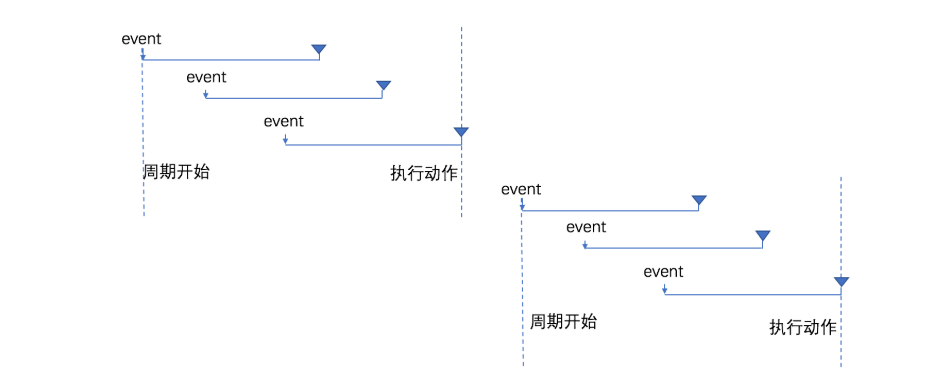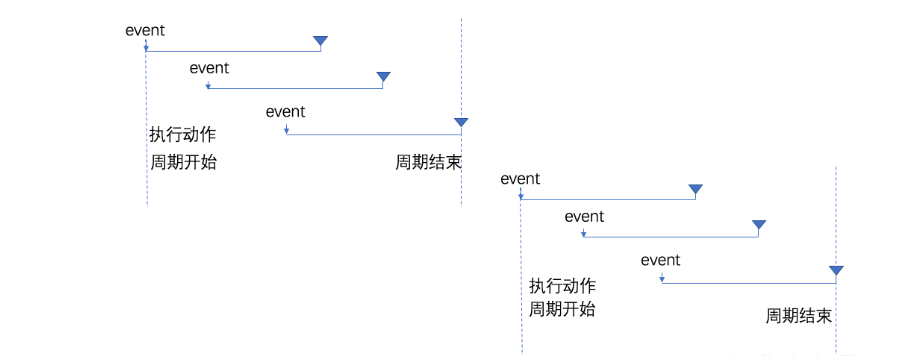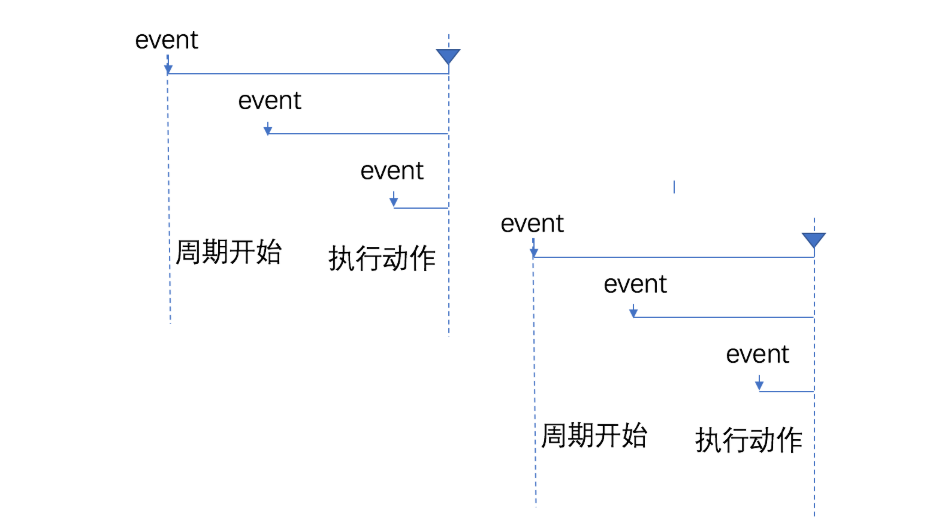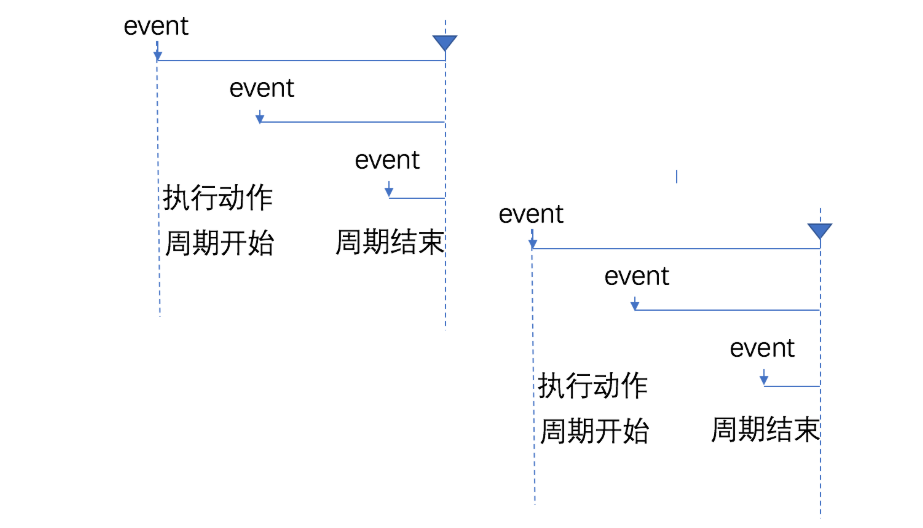前言
首先来举个例子。百度首页的百度输入框,用户输入的时候,每次输入的信息,我们都能看到百度服务器返回给我们的联想关键字。我们每改动一个字,它就换一次联想词,这是我们肉眼能看到的速度,实际上如果不加以处理,可能已经上服务器发起了好几十次的同一个关键字联想请求了,具体速度依赖于不同的pc等机器上的运行速度不同。那么,刚刚也谈到,对于同一个关键字,请求这么多次,也许想给用户呈现的就一次,剩下的请求都是浪费的,并且如果成千上万甚至上亿的用户同时请求,对服务器的负担是巨大的。
防抖与节流解决的问题
从上面的例子,我们需要寻求一个解决方案。防抖和节流就是针对响应跟不上触发频率这类问题的两种解决方案。在给DOM绑定事件时,有些事件我们是无法控制触发频率的。 如鼠标移动事件onmousemove, 滚动滚动条事件onscroll,窗口大小改变事件onresize,瞬间的操作都会导致这些事件会被高频触发。 如果事件的回调函数较为复杂,就会导致响应跟不上触发,出现页面卡顿,假死现象。 在实时检查输入时,如果我们绑定onkeyup事件发请求去服务端检查,用户输入过程中,事件的触发频率也会很高,会导致大量的请求发出,响应速度会大大跟不上触发。
debounce和throttling的策略
针对此类快速连续触发和不可控的高频触发问题,debounce 和 throttling 给出了两种解决策略:
1. debounce的策略
1.1 延迟debounce
debounce,去抖动。策略是当事件被触发时,设定一个周期延迟执行动作,若期间又被触发,则重新设定周期,直到周期结束,执行动作。 这是debounce的基本思想。
延迟debounce,示意图:

1.2 前缘debounce
在后期进行优化又扩展了前缘debounce,即执行动作在前,然后设定周期,周期内有事件被触发,不执行动作,且周期重新设定。
为什么要这样呢?
试想第一种延迟debounce,我们本来想对用户输入的关键字,发起请求联想的频率降低,但是如果用户在我们设定的时间中,一直输入,导致的就是,用户一直看不到关键字,我们倒不如第一次输入的时候就发起一个请求,服务器返回结果,呈现给用户,然后后续用户的键入结束在继续请求)
前缘debounce,示意图

debounce的特点是当事件快速连续不断触发时,动作只会执行一次。 延迟debounce,是在周期结束时执行,前缘debounce,是在周期开始时执行。但当触发有间断,且间断大于我们设定的时间间隔时,动作就会有多次执行。
1.3 延迟debounce的实现
var debounce = (fn, wait) => {
let timer, timeStamp=0; // timer and time stamp
let context, args;
let run = ()=>{
timer= setTimeout(()=>{
fn.apply(context,args);
},wait);
}
let clean = () => {
clearTimeout(timer);
}
return function(){
context=this;
args=arguments;
let now = (new Date()).getTime();
if(now-timeStamp < wait){
console.log('reset',now);
clean(); // clear running timer
run(); // reset new timer from current time
}else{
console.log('set',now);
run(); // last timer alreay executed, set a new timer
}
timeStamp=now;
}
}
1.4 前缘debounce的实现
// 优化版: 定时器执行时,判断start time 是否向后推迟了,若是,设置延迟定时器
var debounce = (fn, wait) => {
let timer, startTimeStamp=0;
let context, args;
let run = (timerInterval)=>{
timer= setTimeout(()=>{
let now = (new Date()).getTime();
let interval=now-startTimeStamp
if(interval<timerInterval){ // the timer start time has been reset, so the interval is less than timerInterval
console.log('debounce reset',timerInterval-interval);
startTimeStamp=now;
run(timerInterval-interval); // reset timer for left time
}else{
fn.apply(context,args);
clearTimeout(timer);
timer=null;
}
},timerInterval);
}
return function(){
context=this;
args=arguments;
let now = (new Date()).getTime();
startTimeStamp=now;
if(!timer){
console.log('debounce set',wait);
run(wait); // last timer alreay executed, set a new timer
}
}
}
1.5 在前缘debounce基础上再添加一个是否立即执行的选项
// 增加前缘触发功能
var debounce = (fn, wait, immediate=false) => {
let timer, startTimeStamp=0;
let context, args;
let run = (timerInterval)=>{
timer= setTimeout(()=>{
let now = (new Date()).getTime();
let interval=now-startTimeStamp
if(interval<timerInterval){ // the timer start time has been reset,so the interval is less than timerInterval
console.log('debounce reset',timerInterval-interval);
startTimeStamp=now;
run(timerInterval-interval); // reset timer for left time
}else{
if(!immediate){
fn.apply(context,args);
}
clearTimeout(timer);
timer=null;
}
},timerInterval);
}
return function(){
context=this;
args=arguments;
let now = (new Date()).getTime();
startTimeStamp=now; // set timer start time
if(!timer){
console.log('debounce set',wait);
if(immediate) {
fn.apply(context,args);
}
run(wait); // last timer alreay executed, set a new timer
}
}
}
2. throttling节流的策略
throttling,节流的策略是,固定周期内,只执行一次动作,若有新事件触发,不执行。周期结束后,又有事件触发,开始新的周期。 节流策略也分前缘和延迟两种。
与debounce类似,延迟是指 周期结束后执行动作,前缘是指执行动作后再开始周期。
2.1 延迟throttling示意图:

2.2 前缘throttling示意图

2.3 延迟throttling的实现
// 简单版: 定时器期间,只执行最后一次操作
var throttling = (fn, wait) => {
let timer;
let context, args;
let run = () => {
timer=setTimeout(()=>{
fn.apply(context,args);
clearTimeout(timer);
timer=null;
},wait);
}
return function () {
context=this;
args=arguments;
if(!timer){
console.log("throttle, set");
run();
}else{
console.log("throttle, ignore");
}
}
}
2.4 前缘throttling的实现
/// 增加前缘
var throttling = (fn, wait, immediate) => {
let timer, timeStamp=0;
let context, args;
let run = () => {
timer=setTimeout(()=>{
if(!immediate){
fn.apply(context,args);
}
clearTimeout(timer);
timer=null;
},wait);
}
return function () {
context=this;
args=arguments;
if(!timer){
console.log("throttle, set");
if(immediate){
fn.apply(context,args);
}
run();
}else{
console.log("throttle, ignore");
}
}
}
总结
debounce和throttling 各有特点,在不同 的场景要根据需求合理的选择策略。如果事件触发是高频但是有停顿时,可以选择debounce; 在事件连续不断高频触发时,只能选择throttling,因为debounce可能会导致动作只被执行一次,界面出现跳跃。